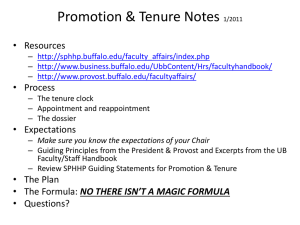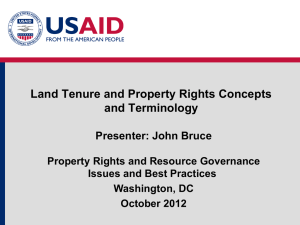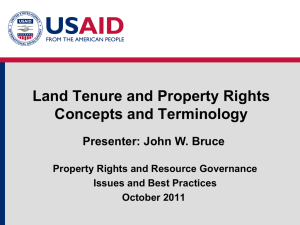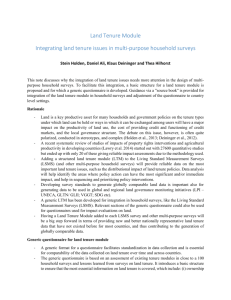Module 5 - Land Tenure and Property Rights Portal
advertisement
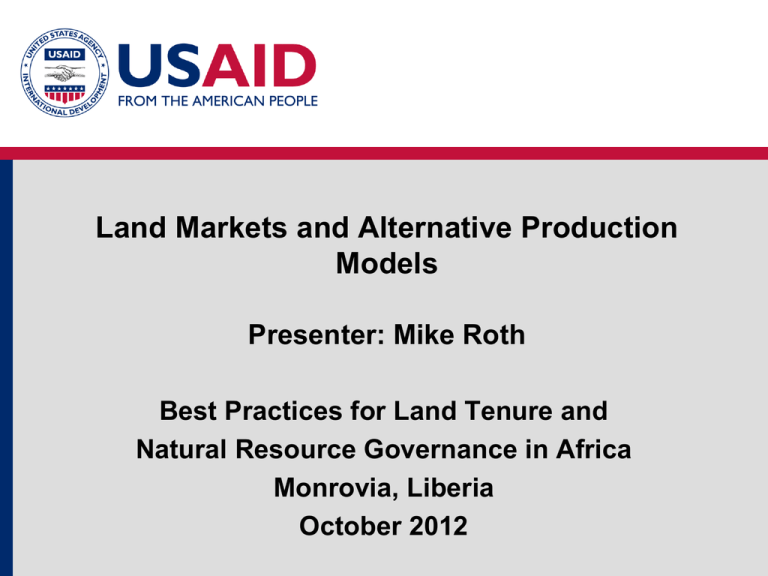
Land Markets and Alternative Production Models Presenter: Mike Roth Best Practices for Land Tenure and Natural Resource Governance in Africa Monrovia, Liberia October 2012 Policy Domain—Land Reform to Consolidation Problem Examples • Land and agrarian reform in Southern Africa Break-up of Large Scale Holdings • Privatization and farm restructuring in Eastern Europe and Former Soviet Union • Break up of State farms/landholdings Management of Common Pool Resources Consolidation/ Management of Small Fragmented Landholdings • Management of fauna and wildlife in Kenya, Namibia and South Africa • Certain farm worker equity share schemes in South Africa • Small holders leasing out land to private investors, Ethiopia • Land use consolidation, Rwanda • Linking small holders with investors, Mozambique, Angola 2 Alternative Tenure Forms Ownership Individual Tenure Models • • • • • • Freehold property Leasehold property Rental/sharecropping Customary Land Tenure Contract Farming Trusts/Conservancies Group • Common Property Associations/Community Demarcations • Community Based NRM • Agricultural Production Cooperative (APC) • Conservancies/Trusts • Company • Equity Sharing Model State • Co-management 3 Model Challenges 1. Incentivized Owners/Workers – Incentives to work the land; ability to monitor and supervise labor 2. Capital Intensity – Capital is mobile; voting rights and dividends are proportional to investment; land and assets serviceable as collateral; credit available 3. Economies of Scale – Ability to manage lumpy inputs; net income/ha increases with landholding size 4. Market Coordination – horizontal, upstream, downstream 4 Models and Property Rights 1. Property rights not mentioned as a challenge: • Property rights typically range from poor to good within each type of model complicating performance assessment • Organization features (governance, management) of corporate models are also highly variable • Long learning curve for corporate models – time is required for new beneficiaries to gain capacity 2. Having strong property rights and organizational features is essential for achieving high performance across all models 5 Tenure Model: Individualization Performance Challenges Incentivized Owners/ Workers Capital Intensity (D=S) Economies of Scale Market Coordination • Small Scale ++ – – –– • Large Scale – ++ + ++ Freehold/Leasehold Complementary Policies to Improve Performance: Small Scale: • Microfinance • Producer associations • Registration and Title • Agricultural extension Large Scale: • Farm worker rights legislation • Worker empowerment • Worker ownership 6 Tenure Model: Community Demarcation Performance Challenges Incentivized Owners/ Workers Capital Intensity (D=S) Economies of Scale Market Coordination Community Demarcation –– –– – –– Common Property Association +– –– – –– Complementary Policies to Improve Performance: • Inside boundary registration • Promote ease of entry and exit in transferring capital invested • Community mobilization • Producer associations • Agricultural research & extension • Leasing contracts and enforcement to facilitate outside investment 7 Tenure Model: Enabling Land Rental Markets Performance Challenges Incentivized Owners/ Workers Capital Intensity (D=S) Economies of Scale Market Coordination Land Rental + –+ +– +– Sharecropping + –+ +– + ++ + +– + Contract Farming Complementary Policies to Improve Performance: • Registration and Title • Producer associations • Leasing contract and • Agricultural research & extension enforcement • Market contract and enforcement • Microfinance 8 Institutional Arrangements for Successful Group Farming: Objectives 1. Encourage ownership & empower decision making 2. Increase (sometimes redistribute) wealth and future benefit streams 3. Empower farmworkers 4. Retain or attract quality management 5. Source capital from the private sector 6. Improve worker productivity & labor relations 7. Grow wealth and create wages, profit and dividends 9 Tenure Model: Cooperatives Performance Challenges Incentivized Owners/ Workers Capital Intensity (D=S) Economies of Scale Market Coordination Agricultural Production Coop –– +– +– + Agricultural Marketing Coop + + – + Complementary Policies to Improve Performance: • Discourage APC and locking • Establish land holding company that member’s land into the coop • Make voting and benefit rights proportional to investment leases land to the coop • Promote accountability, transparency, and good governance 10 Tenure Model: Company or FWES Model Performance Challenges Company (FWES) type models Incentivized Owners/ Workers Capital Intensity (D=S) Economies of Scale Market Coordination ++ +– + + Complementary Policies to Improve Performance: • Workers aid in design and participate • Impose ST moratorium on sale of in decision making • Make voting/benefit rights proportional to investment • Develop/observe LT business plan • Dispute resolution procedures shares to avoid sudden outflows of equity; preserve credit worthiness • Work on accountability, transparency (external audits), and good governance 11 Take Aways 1. No single best alternative model. Property rights range from poor to good within each 2. All models can achieve good performance in the right context especially if property rights and organizational features are provided 3. Certain models (APCs) consistently have poor performance 4. Focus on first things first: individualization and land markets 5. Corporate models require considerable facilitation of communities to build capacity and involve outside investors 6. Promote a diversified agrarian structure. Aim public support at encouraging evolution, and providing complementary policy support. Be gradual 7. Be wary of recurrent public costs 12

